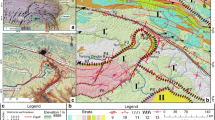Abstract
The 1718 great Tongwei earthquake in northwest China caused more than 300 large-scale landslides near the epicenter resulting in more than 70,000 deaths. Although previous studies agree that the earthquake-induced landslides in the area are loess-landslides, which slid along ancient terrain surfaces, there is a dearth of evidence to unravel the actual failure mechanisms of these widely-documented events. To clarify their characteristics and mechanisms, the landslides in Pan’an Town, located in Gansu Province, China were rigorously investigated. The field surveys revealed that the landslides occurred in an area comprising loess deposits of several tens of meters underlain by a basal mudstone layer. It was also revealed that instability in the area is strongly influenced by a river valley with large erosion bank slopes, as well as steep mudstone slopes, which are well developed. The majority of the landslides triggered by the Tongwei earthquake were loess-mudstone composite landslides, with the sliding surface in the deep mudstone. Three huge landslides on the northern mountain located at the river bend of Pan’an Town with a total volume of about 6.06 × 108 m3 are the main mass movements during the 1718 catastrophe. In addition, by taking the typical landslide named the Weijiawan landslide as a case study, the internal structure of the earthquake-triggered landslides and their stability were studied. The new findings not only aided the unraveling of the failure mechanisms but also provided insights and knowledge on early recognition of earthquake-triggered landslides in northwest China towns, especially in the surrounding valley, which shares similar geological conditions with landslides studied in this paper.


























Similar content being viewed by others

References
Chen YM, Shi YC, Liu HM, Lu YX (2005) Distribution characteristics and influencing factors analysis of seismic loess landslides. Earthquake research in China 21(2):235–243
Cui P, Zhu YY, Han YS, Chen XQ, Zhuang JQ (2009) The 12 May Wenchuanearthquake-induced landslide lakes: distribution and preliminary risk evaluation. Landslides 6:209–223
Harp EL, Jibson RW (1996) Landslides triggered by the 1994 Northridge, Californiaearthquake. Bull Seismol Soc Am 86:319–332
Harp EL, Jibson RW (2002) Anomalous concentrations of seismically triggered rockfalls in Pacoima Canyon: are they caused by highly susceptible slopes or localamplification of seismic shaking? Bull Seismol Soc Am 92:3180–3189
Huang RQ, Li WL (2009) Analysis of the geo-hazards triggered by the 12 May 2008 Wenchuan earthquake, China. Bull Eng Geol Environ 68:363–371
Keefer DK (1984) Landslides caused by earthquakes. Geol Soc Am Bull 95:406–421
Kuhlemeyer RL, Lysmer J (1973) Finite element method accuracy for wave propagation problems. J Soil Mech Found Div ASCE 99(SM5):421–427
Liu BC, Zhou JX, Li QM (1984) Interpretation on the aerial photograph of 1718 Tongwei earthquake and 1654 Tianshui earthquake. Seism Res 1:1–7
Morgenstern NR, Price VE (1965) The analysis of the stability ofgeneral slip surface. Geotechnique 23(1):85–100
Sassa K (1988) Geotechnical model for the motion of landslides. In: Special Lecture of 5th International Symposium on Landslides, Landslides, 1988, 10–15 July, vol 1, pp 37–55
Sassa K (1996) Prediction of earthquake induced landslides. In: Senneset K (Ed.), Landslides. Balkema, Rotterdam, pp 115–132
Scheidegger AE (1973) On the prediction of the reach and velocity of catastrophic landslides. Rock Mech 5:231–236
Sun P, Yin YP, Wu SR, Wang FW, Chen LW (2009) An experimental study on the initiation mechanism of rapid and long runout loess landslides triggered by earthquake. J E Geol 17(4):1–6
Sun P, Zhang YS, Shi JS (2011) Analysis on the dynamical process of Donghekou rapid long run-out landslide-debris flow triggered by great Wenchuan earthquake. J Mountain Sci 8(2):140–148
Sun P, Yin YP, Wu SR, Chen LW (2012) Does vertical seismic force play an important role for the failure mechanism of rock avalanches? A case study of rock avalanches triggered by the Wenchuan earthquake of May 12, 2008, Sichuan, China. Environ Earth Sci 66(5):1285–1293
Wu WJ, Wang NQ (2006) Landslides in Gansu Province. Lanzhou University Press, Lanzhou, pp 88–97
Yin YP, Wang FW, Sun P (2009) Landslide hazards triggered by the 2008 Wenchuanearthquake, Sichuan, China. Landslides 6:139–152
Zheng YR, Chen Y, Wang GX et al (2007) Engineering treatment ofslope and landslide. China Communications Press, Beijing
Kuhlemeyer RL, Lysmer J (1973) Finite element method accuracy for wave propagation problems. Journal of the Soil Mechanics and Foundations Division, ASCE, 99(SM5): 421-427
Acknowledgments
This research was supported by the NSFC (Award No. 41472296 and No. 41372374), and the China Geological Survey (Project No. 12120114035901). The authors would like to sincerely thank Prof. Wang F.W. of Shimane University, Japan, who gave good suggestions for this paper. We are grateful to the Editor in Chief of Bulletin of Engineering Geology and the Environment, Martin Gordon Culshaw, for supporting the possible publication of our study. Finally, the authors’ special appreciation goes to the reviewers of this manuscript for their useful comments.
Author information
Authors and Affiliations
Corresponding author
Rights and permissions
About this article
Cite this article
Sun, P., Li, R., Jiang, H. et al. Earthquake-triggered landslides by the 1718 Tongwei earthquake in Gansu Province, northwest China. Bull Eng Geol Environ 76, 1281–1295 (2017). https://doi.org/10.1007/s10064-016-0949-4
Received:
Accepted:
Published:
Issue Date:
DOI: https://doi.org/10.1007/s10064-016-0949-4



